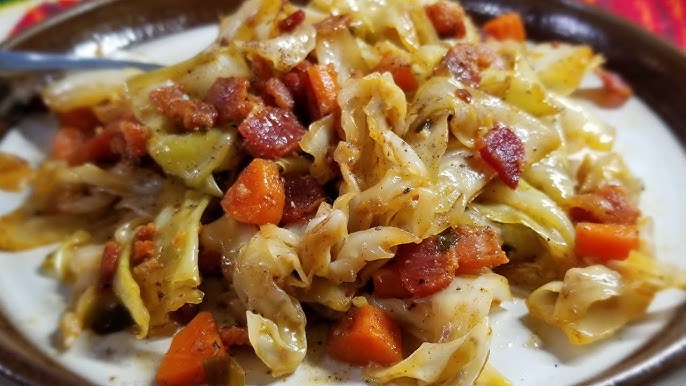Cabbage Bacon Recipe: When it comes to comfort food that’s both hearty and budget-friendly, the combination of cabbage and bacon never disappoints. This simple yet delicious dish has been a staple in many kitchens for generations. Cabbage, with its slightly sweet and earthy flavor, balances perfectly with the smoky, salty richness of crispy bacon. The result is a savory side dish—or even a main course—that pairs beautifully with almost any meal.
What makes cabbage and bacon so special is how easily they come together with minimal ingredients. With just a head of cabbage, a few strips of bacon, some onions, and a handful of seasonings, you can create a dish that’s packed with flavor. It’s one of those recipes that proves you don’t need fancy ingredients to make something truly mouthwatering.
Another reason this dish is a favorite in many households is its versatility. You can enjoy it as a side dish with roasted chicken, pork chops, or grilled steak. On the other hand, you can also serve it as a standalone dish by adding a few more hearty ingredients like potatoes or sausage. Whether you’re cooking for a weeknight dinner or preparing a quick dish for a family gathering, cabbage with bacon is always a winner.
In this step-by-step guide, we’ll break down everything you need to know. From choosing the best ingredients to walking you through each stage of the cooking process, you’ll learn how to make this classic dish with ease. And the best part? It doesn’t take hours in the kitchen. Within 30–40 minutes, you’ll have a warm, flavorful dish ready to serve.
Ingredients You’ll Need
To make this cabbage bacon recipe, you don’t need a long grocery list. Most of the items are pantry staples you probably already have at home. Here’s everything you’ll need to create the perfect dish:
- 1 medium head of cabbage (green or savoy, shredded or chopped)
- 6–8 strips of bacon (smoked or unsmoked, depending on preference)
- 1 medium onion (thinly sliced)
- 2–3 cloves of garlic (minced)
- 2 tablespoons butter or olive oil (optional, for extra richness)
- Salt and black pepper to taste
- ½ teaspoon paprika (optional, for a smoky kick)
- ¼ teaspoon red pepper flakes (optional, for heat)
- Fresh parsley or dill (for garnish)
Optional Add-Ons:
- Sliced carrots for a touch of sweetness
- Diced potatoes for a heartier version
- Smoked sausage or ham for extra protein
- A splash of apple cider vinegar for a tangy twist
The beauty of this recipe is its flexibility. You can keep it simple with just cabbage and bacon, or you can elevate it by adding extra vegetables and spices to match your personal taste.
Choosing the Right Ingredients
The flavor of your dish largely depends on the quality of ingredients you choose. Here are some helpful tips to make sure you get the best results:
How to Select the Best Cabbage
When buying cabbage, look for a head that feels heavy for its size. The leaves should be tightly packed, firm, and vibrant in color. Avoid cabbages with wilted or yellowing leaves, as they may be past their prime. Green cabbage is the most commonly used variety for this dish, but savoy cabbage adds a softer texture and slightly sweeter taste.
Picking the Right Cut of Bacon
Bacon is the star of this recipe, so it’s important to choose wisely. Thick-cut bacon works best because it gives you meaty bites that stand up to the cabbage’s texture. Smoked bacon adds an extra layer of flavor, while unsmoked bacon allows the sweetness of the cabbage to shine through. If you prefer a leaner option, you can use turkey bacon, though the flavor will be less intense.
Fresh vs. Dried Herbs
Fresh parsley, dill, or thyme can brighten up the dish with fresh flavors. However, if you don’t have fresh herbs on hand, dried herbs work just as well—just remember they’re more concentrated, so use about half the amount.
Kitchen Tools You’ll Need
You don’t need a fancy setup to prepare this recipe, but having the right tools will make cooking easier and more enjoyable. Here’s what you’ll need:
- Large skillet or frying pan: Preferably cast iron or stainless steel, since they distribute heat evenly and allow for proper browning.
- Sharp knife: For chopping cabbage, slicing onion, and cutting bacon.
- Cutting board: A sturdy surface for prepping your ingredients.
- Mixing spoon or spatula: Wooden or silicone spoons work well for stirring without scratching your pan.
- Measuring spoons: For seasonings, though you can also season by taste if you prefer.
Optional but useful:
- Colander: For washing and draining cabbage.
- Tongs: To flip bacon strips easily.
- Lid for the skillet: Helps steam the cabbage and cook it evenly.
Having these tools ready before you start cooking will make the process smooth and hassle-free.
Step-by-Step Guide to Cooking Cabbage with Bacon
Now comes the exciting part—actually cooking the dish! Follow these detailed steps to make sure your cabbage with bacon turns out perfectly every time.
Step 1 – Prepping the Ingredients
Preparation is key. Start by washing your cabbage thoroughly under cold running water to remove any dirt or residue. Cut the cabbage into quarters, remove the core, and then shred or chop it into bite-sized pieces.
Next, slice your onion thinly and mince the garlic. Cut the bacon into small strips or bite-sized pieces—it will cook faster and distribute more evenly throughout the dish this way. At this point, you should also measure out your spices so they’re ready to add as you cook.
Taking a few extra minutes to prep everything before turning on the stove makes the cooking process much smoother. That way, you won’t feel rushed and your ingredients won’t overcook while you’re still chopping the next one.
Step 2 – Cooking the Bacon to Crispy Perfection
Bacon is the star of this recipe, so getting it just right is essential. Start by placing your chopped bacon pieces into a cold skillet. This may sound unusual, but beginning with a cold pan allows the fat to slowly render out of the bacon as it heats up. That rendered fat is gold—it’s what you’ll use to cook the cabbage and onions later, giving them a smoky, savory flavor.
Turn the heat to medium and let the bacon cook slowly, stirring occasionally to prevent sticking. If you cook it too fast on high heat, the bacon can burn on the outside while remaining chewy inside. Patience pays off here—you want evenly browned, crispy bacon pieces with plenty of flavorful fat left in the pan.
Once the bacon is fully cooked and crispy, use a slotted spoon to remove the pieces and set them aside on a paper towel-lined plate. Don’t discard the bacon grease—this is what makes the cabbage rich and delicious. If you find that the bacon has released too much grease, you can pour off some, but be sure to leave at least 2–3 tablespoons in the skillet. This will form the base for the next step of the recipe.
If you’re using turkey bacon or another leaner substitute, you may not get enough fat in the pan to cook the vegetables. In that case, add a tablespoon of butter or olive oil to supplement. But if you’re cooking with traditional pork bacon, you’ll have plenty of flavorful drippings to work with.
Remember: perfectly cooked bacon isn’t just about crispiness—it’s about building flavor. That smoky-salty richness will infuse every bite of cabbage, making this dish irresistible.
Step 3 – Sautéing Onion and Garlic
With the bacon out of the pan and the rendered fat left behind, it’s time to build your flavor base. Add the sliced onion directly into the skillet and cook over medium heat. Stir occasionally, letting the onion absorb the bacon drippings. Within a few minutes, the onions will begin to soften and turn golden brown. That slight caramelization brings sweetness that balances the salty bacon and earthy cabbage.
Once the onion has softened, add the minced garlic. Be careful here—garlic cooks quickly and can burn if left unattended. Stir constantly for about 30 seconds until it becomes fragrant. The smell of garlic sizzling in bacon fat is heavenly, and it signals that your dish is developing layers of flavor.
At this stage, you can also add optional ingredients like sliced carrots or diced potatoes if you’re making a heartier dish. Add them before the cabbage so they have time to soften properly. The goal is to create a flavorful foundation that will coat and season the cabbage as it cooks.
This step may seem simple, but it’s what elevates the recipe. By layering bacon, onion, and garlic, you create a flavor base that transforms ordinary cabbage into something rich, smoky, and deeply satisfying.
Step 4 – Adding and Cooking the Cabbage
Now it’s time for the main ingredient—cabbage. Add the chopped or shredded cabbage directly into the skillet with the onion and garlic mixture. Don’t worry if the pan looks crowded at first. Cabbage has a high water content and will shrink significantly as it cooks, reducing in volume by nearly half.
Use a large spoon or spatula to toss the cabbage in the bacon fat and onion mixture. Make sure every piece is lightly coated so the flavor distributes evenly. Sprinkle in your seasonings—salt, black pepper, paprika, and a pinch of red pepper flakes if you like some heat. Go light on the salt at first since the bacon is already salty; you can always adjust later.
Cover the skillet with a lid and let the cabbage cook for about 5–7 minutes, stirring occasionally. The steam helps soften the cabbage while the direct heat caramelizes the edges. This combination gives you tender cabbage with just the right amount of bite.
If you prefer your cabbage softer, cook it a little longer with the lid on, adding a splash of water or chicken broth to help it steam. For a crisp-tender texture, cook uncovered and stir often until it reaches your desired doneness.
This step is where cabbage goes from raw and crunchy to tender, flavorful, and infused with smoky richness. Watching the transformation is part of the magic of this dish.
Step 5 – Combining Everything Together
Once the cabbage has softened and cooked through, it’s time to bring everything together. Add the crispy bacon pieces back into the skillet and stir them into the cabbage mixture. The heat from the cabbage will warm the bacon, ensuring every bite has that perfect balance of smoky crunch and tender sweetness.
At this stage, taste the dish and adjust the seasonings. If you feel it needs more depth, add a small splash of apple cider vinegar for tanginess or an extra pinch of paprika for smokiness. A touch of fresh herbs like parsley or dill at the very end adds brightness and makes the dish feel fresh.
Serve the cabbage and bacon hot as a side dish or enjoy it as a standalone meal. It pairs wonderfully with roasted meats, but it’s also satisfying on its own when paired with crusty bread or boiled potatoes.
And there you have it—a simple, affordable, and mouthwatering dish made with just a handful of ingredients. The step-by-step process ensures you get tender cabbage, perfectly crisp bacon, and a balance of flavors that will make this recipe a favorite in your kitchen.
Serving Suggestions for Cabbage and Bacon
Once your cabbage and bacon are cooked to perfection, you’ll want to think about how to serve it. While this dish shines on its own, pairing it with complementary foods can turn it into a memorable meal.
One of the most classic ways to enjoy cabbage and bacon is as a side dish with roasted or grilled meats. Think roast chicken, baked pork chops, or a juicy steak. The smoky-salty flavor of bacon enhances these proteins beautifully. If you’re hosting a family dinner, serve the cabbage alongside mashed potatoes and gravy—it feels like a warm, comforting Sunday meal.
You can also serve it as part of a hearty breakfast. Pair it with fried eggs, hash browns, and toast for a filling start to your day. In fact, in many cultures, cabbage with bacon is enjoyed in the morning because it’s both energizing and satisfying.
If you want to keep things light, serve it with a fresh green salad or some buttered noodles. The cabbage brings a savory element that balances lighter sides. Another creative idea is to use the cabbage and bacon mixture as a filling for wraps or stuffed into warm pita bread. Add a dollop of sour cream or mustard, and you have a quick, delicious lunch.
For drinks, pair this dish with something that balances its richness. A crisp white wine, such as Sauvignon Blanc, or a cold lager works wonderfully. If you prefer non-alcoholic options, sparkling water with lemon or a glass of iced tea will keep things refreshing.
In short, this dish is extremely versatile. Whether you’re serving it with meat, potatoes, bread, or salad, it’s bound to make the meal heartier and more flavorful.
Variations of the Cabbage Bacon Recipe
One of the best things about this recipe is how easily you can customize it to suit your taste. While the classic version calls for just cabbage, bacon, onions, and garlic, there are countless ways to put your own spin on it.
- Add Potatoes: For a heartier version, dice potatoes into small cubes and cook them along with the onions. They absorb the bacon flavor beautifully and make the dish more filling.
- Mix in Sausage: Smoked sausage or kielbasa can be added for an even richer, meatier taste. Slice it thin and cook it with the onions before adding the cabbage.
- Spice It Up: If you love bold flavors, don’t shy away from spices. A sprinkle of chili flakes, cayenne pepper, or even Cajun seasoning can take the dish in a whole new direction.
- Go Creamy: Add a splash of heavy cream or a dollop of sour cream at the end for a creamy cabbage and bacon dish. This variation works especially well as a side to grilled chicken or turkey.
- Incorporate Vinegar: For a tangy, German-inspired twist, add apple cider vinegar or balsamic vinegar to the cabbage as it cooks. The acidity balances out the richness of the bacon.
- Use Red Cabbage: Swap out green cabbage for red cabbage. It will give the dish a slightly sweeter taste and a beautiful pop of color.
The flexibility of this recipe means you’ll never get bored. Whether you want something hearty, spicy, tangy, or creamy, a few small tweaks can transform the flavor profile completely.
Tips for Perfect Cabbage with Bacon Every Time
Even though this recipe is straightforward, a few cooking tips can help you take it from good to amazing:
- Don’t Overcook the Cabbage: Cabbage tastes best when it still has a slight crunch. Overcooking can make it mushy and less flavorful.
- Render the Bacon Slowly: Start with a cold pan and let the bacon cook slowly. This ensures you get the most flavorful fat for sautéing.
- Taste and Adjust Seasonings: Since bacon is naturally salty, it’s best to season lightly at first and adjust before serving.
- Add Ingredients in Layers: Cook bacon first, then onions, then garlic, and finally cabbage. This layering creates a depth of flavor you won’t get if you dump everything in at once.
- Experiment with Texture: For a more caramelized flavor, cook the cabbage uncovered and let it brown slightly. For softer cabbage, cook it covered with a lid.
- Don’t Skip the Garnish: Fresh herbs like parsley, dill, or even green onions brighten the dish and add freshness.
With these tips in mind, you’ll be able to consistently prepare cabbage and bacon that tastes restaurant-quality, right in your own kitchen.
Storing and Reheating Leftovers
One of the great things about cabbage and bacon is that it reheats well, making it perfect for meal prep or leftovers.
- Storing: Allow the dish to cool completely before transferring it into an airtight container. Store in the refrigerator for up to 3–4 days.
- Freezing: While you can freeze it, cabbage tends to lose some of its texture after thawing. If you do freeze it, store in a freezer-safe container for up to 2 months.
- Reheating: The best way to reheat cabbage and bacon is on the stove. Place it in a skillet over medium heat and stir until warmed through. You may need to add a splash of water or broth to keep it from drying out. Alternatively, you can microwave it in short intervals, stirring in between.
If you’re meal prepping, consider making a large batch of cabbage and bacon. It pairs well with multiple proteins and can be used in wraps, sandwiches, or as a quick side dish throughout the week.
FAQs about Cabbage Bacon Recipe
1. Can I make cabbage and bacon ahead of time?
Yes! You can prepare it a day in advance and store it in the fridge. Reheat it in a skillet for the best flavor and texture.
2. What type of cabbage works best for this recipe?
Green cabbage is the most common, but savoy cabbage gives a softer texture and slightly sweeter flavor. Red cabbage works too but will change the color of the dish.
3. Can I make this dish vegetarian?
Absolutely. Simply skip the bacon and use olive oil or butter instead. For a smoky flavor, add a dash of smoked paprika.
4. What can I serve cabbage and bacon with?
It pairs perfectly with roasted chicken, pork chops, steak, or even fried eggs and toast. You can also serve it with mashed potatoes or in wraps.
5. How do I keep my cabbage from turning soggy?
Cook it over medium heat and avoid overcooking. If you want more texture, cook uncovered so the cabbage browns and caramelizes instead of steaming too much.
Conclusion
The step-by-step guide we’ve gone through shows that cooking this dish isn’t complicated at all. By preparing your ingredients, rendering bacon slowly, layering flavors with onions and garlic, and seasoning thoughtfully, you can create a meal that’s both budget-friendly and delicious. Add in the flexibility of variations—like potatoes, sausage, or vinegar—and you’ll never run out of new ways to enjoy it.
Whether served as a side with roasted meats or as the star of the meal, cabbage and bacon is sure to satisfy. It’s simple enough for beginners but flavorful enough to impress seasoned cooks. If you haven’t tried making it yet, now’s the perfect time.



